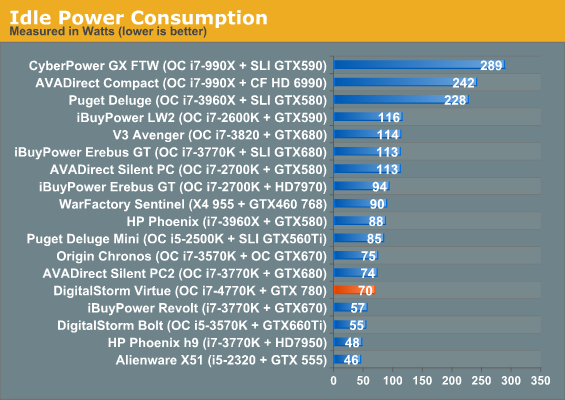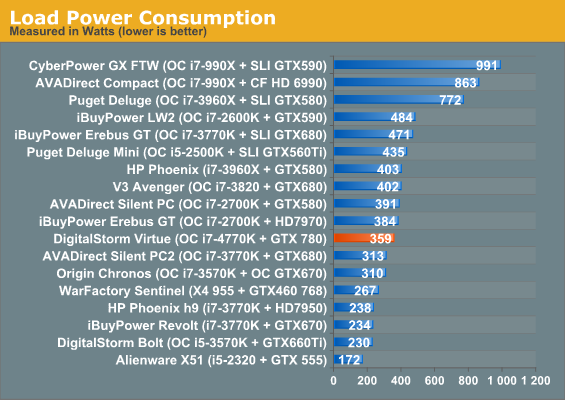Haswell and GK110 vs. Ivy and GK104: DigitalStorm Virtue System Review
by Dustin Sklavos on June 23, 2013 12:00 PM ESTBuild Quality
It's not entirely fair to DigitalStorm not to mention the generally excellent job they've done with the build quality of the Virtue. One of the ways a boutique can distinguish itself is in its component selection, and the stock component choices of the Virtue line are solid across the board.
Starting with the chassis selection, I'm actually a pretty big fan of the Corsair Obsidian 350D and I'm happy to see it being employed in a high performance system. Interestingly, DigitalStorm is also using Corsair's H100i to cool the CPU, but they're not employing Corsair Link software to control fan speed despite the system being wired to use it. Instead, the fans on the H100i (oriented beneath the radiator to pull in air from the top of the enclosure and then cycle it out of the rear exhaust) run at a fixed fan speed. I personally find variable fan speed to be distracting; I'd just as soon the whole system run silent all the time, end of discussion. DigitalStorm's choice here works for me.
.jpg)
The 350D also does an excellent job of showing off NVIDIA's reference cooler for the GeForce GTX 780, complete with the subtly glowing "GeForce GTX" logo. That's plugged into an ASUS Z87 Gryphon motherboard, and the system drive is a healthy 120GB Corsair Neutron GTX featuring an LAMD controller. Given all the Corsair kit in the Virtue, though, I'm actually surprised the memory is A-Data.
Where I'd be tempted to shake down DigitalStorm is in using a single stable voltage for overclocking the i7-4770K, but without more experience with Haswell and the quirks of its VRM I can't say if that's worth caring about or not. With the first generation chips (Nehalem, Clarksfield, Gulftown), this was a huge issue, but Sandy and Ivy were less problematic and it looks like Haswell is even less so. I do want to point out that DigitalStorm has traditionally been more aggressive about their CPU voltages than I'd like, but the i7-4770K's 1.28V is actually pretty common and totally reasonable.
Noise and Heat
Demonstrating a healthy amount of balance in their design, the Virtue isn't especially silent but is generally a touch quieter than enthusiast gaming desktops tend to be. Idle noise is around ~33dB, and since the CPU and chassis fans run at a fixed speed, the GeForce GTX 780 is really the only component that spins up or down. Unfortunately, while the 350D is an excellent case for liquid cooling, it does suffer slightly from Corsair's perpetual issues with middling air cooling performance.

Thermals on the GTX 780 are pretty par for the course, but it can jack noise levels up a couple of dB under sustained load. Meanwhile, the i7-4770K is really about where it needs to be. A more adventurous user might be able to eke a little more performance out of it with a little more juice, but I'd hesitate to push the H100i that much harder, especially without bumping the fan speeds up to a potentially uncomfortable volume.
Power Consumption
So how much power does a modern high end gaming system pull from the wall? The last couple of generations from Intel, NVIDIA, and AMD (Bulldozer/Piledriver notwithstanding) have all done an admirable job of continually reducing idle and load power consumption alike, so the DigitalStorm Virtue stands to benefit from those advances.


And it does. While neither one is abnormally spectacular, they're both totally reasonable. I'm not convinced DigitalStorm couldn't shave 10W or so off the idle power, but load power is where it ought to be.


_thumb.jpg)
_thumb.jpg)
_thumb.jpg)
_thumb.jpg)
_thumb.jpg)
_thumb.jpg)








70 Comments
View All Comments
HideOut - Sunday, June 23, 2013 - link
That 5ghz chip is also 220w part. Not even close to relevant to most reasonable pc users. It's a marketing gimmick.wumpus - Monday, June 24, 2013 - link
The computer in question has a 250W GPU and a 1000W power supply, there is no reason to veto a 220W CPU. While I think the Nvidia 780 is a "marketing gimick" (pretty much the same additional performance/cost), it seems to be a minority opinion on this site.MrSpadge - Monday, June 24, 2013 - link
That 220 W is the reason Intels dismisses such CPUs, as they'd hardly sell at all. How ever would be interested in such beasts is already covered with the current Ks and Extremes, including factory OC'ed builds.Klimax - Tuesday, June 25, 2013 - link
220W which won't beat my 3930k on conservative overclocking 4.4GHz and which is most likely cheaper...MrSpadge - Monday, June 24, 2013 - link
That's rubbish. Super low temperatures always help FETs to work significantly faster. That's why the clock speeds reached with LN2 will NEVER be possible in production untits of the same fundamental technology.And if Intel designed for significantly higher clock speeds they'd loose IPC due to the longer pipeline and would blow the power efficiency gains Intel worked so hard on during the last years completely out of the window. Just remember the Pentium 4 or nVidias hot clock versus Kepler.
Nintendo Maniac 64 - Sunday, June 23, 2013 - link
Contrary to what everyone is saying, I and several others have discovered that Haswell is surprising fast at emulation - around 20% faster than Ivy and 30% faster than Sandy. If would be great if a review site like Anand would actually benchmark such programs because they are heavily CPU-oriented and currently are one of if not the only compelling reason for Haswell and it'd be a shame if people missed that memo.This forum topic summarizes what I describe:
http://www.overclock.net/t/1402557/haswell-is-surp...
Sabresiberian - Sunday, June 23, 2013 - link
Yeah I agree from an enthusiast viewpoint that Haswell is a little underwhelming, and am irritated that Intel kept the glue-on method of attaching covers, but there are apps in which it crushes Ivy Bridge - and none in which Ivy Bridge is superior.As always, buy your hardware for the applications you most want to support. :)
JDG1980 - Sunday, June 23, 2013 - link
I agree that emulators could work well as CPU benchmarks, especially since many of them are single-threaded or lightly-threaded (so they're a real-world application where IPC is important).PCSX2 running Dragon Quest 8 would be a good benchmark. It uses two CPU threads (three if MTVU is enabled) and is very demanding, especially in busy scenes.
Gigaplex - Monday, June 24, 2013 - link
Running PCSX2 on potentially pirated games for a commercial review is legally dubious at best.p1esk - Sunday, June 23, 2013 - link
So what is exactly the value DigitalStorm brings to the table?It seems to me that they put together a few off the shelf components, and slightly bumped up the frequency. Is that all? If so, that's something anyone who reads this site can do themselves in an hour or less.
What I expect from a "boutique" computer builder is systems like the new Mac Pro, only where I can customize everything and anything.
Otherwise, no, they don't deserve extra $200-300 on top of Newegg BOM.